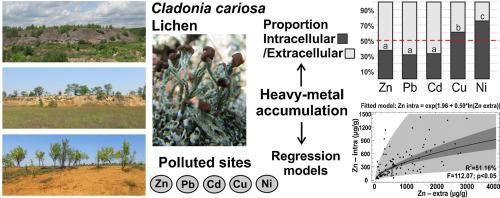当前位置:
X-MOL 学术
›
J. Trace Elem. Med. Bio.
›
论文详情
Our official English website, www.x-mol.net, welcomes your
feedback! (Note: you will need to create a separate account there.)
Insight into the pattern of heavy-metal accumulation in lichen thalli.
Journal of Trace Elements in Medicine and Biology ( IF 3.6 ) Pub Date : 2020-04-04 , DOI: 10.1016/j.jtemb.2020.126512 Kaja Rola 1
Journal of Trace Elements in Medicine and Biology ( IF 3.6 ) Pub Date : 2020-04-04 , DOI: 10.1016/j.jtemb.2020.126512 Kaja Rola 1
Affiliation

|
BACKGROUND
Heavy metals that pass through the plasmalemma are expected to influence on lichen metabolic processes; however, lichens may tolerate high concentrations of metals by sequestrating them extracellularly. Heavy metal accumulation level fundamentally determine the success of lichens in the colonisation of polluted sites; however, the proportions between extra- and intracellular metal concentrations in lichen thalli are still poorly recognized. In this study metal accumulation patterns of selected toxic trace elements, i.e. Pb, Cd, and micronutrients, i.e. Zn, Cu and Ni, in Cladonia cariosa thalli were recognised in relation to extra- and intracellular fractions.
METHODS
The intracellular and total concentrations of Zn, Pb, Cd, Cu and Ni in lichen thalli collected from eleven variously polluted sites were determined by means of atomic absorption spectrometry. Additionally, organic carbon and total nitrogen contents as well as pH of soil substrate were measured.
RESULTS
The accumulation patterns differed between studied metal elements; the major part of Zn, Pb and Cd loads was accumulated extracellularly, whereas Cu and Ni accumulation was mostly intracellular. Like toxic trace elements, Zn was accumulated mainly extracellularly at high polluted sites. The non-linear models most reliably reflect relationships between intracellular and extracellular metal contents in C. cariosa thalli. The intracellular contents of Zn, Pb, Cd and Cu increased slower at higher than at lower extracellular concentrations. Moreover, at higher total concentrations of elements in the thalli, their extracellular proportions were markedly increased.
CONCLUSION
The results suggest that in the face of extreme Zn-enrichment, lichens demonstrate the ability to accumulate the excess of Zn outside the cells. Therefore, it can be concluded that metal accumulation depend not only on the element but also on its abundance in the environment and direct availability for lichens. The studied species showed a defence against excessive intracellular accumulation when a given element is in excess. Such capability may facilitate the colonization of extremely polluted sites by certain pioneer lichens.
中文翻译:

深入了解地衣菌体中重金属积累的模式。
背景技术穿过质膜的重金属预计会影响地衣的代谢过程;然而,地衣可以通过将金属隔离在细胞外来耐受高浓度的金属。重金属积累水平从根本上决定了地衣在污染场地定殖的成功与否;然而,地衣菌体细胞外和细胞内金属浓度之间的比例仍然知之甚少。在本研究中,石蕊叶状体中选定的有毒微量元素(即 Pb、Cd)和微量营养素(即 Zn、Cu 和 Ni)的金属积累模式与细胞外和细胞内部分相关。方法采用原子吸收光谱法测定11个不同污染地点地衣菌体中Zn、Pb、Cd、Cu、Ni的胞内浓度和总浓度。此外,还测量了有机碳和总氮含量以及土壤基质的pH值。结果所研究的金属元素之间的积累模式不同; Zn、Pb 和 Cd 负荷的主要部分积累在细胞外,而 Cu 和 Ni 的积累主要在细胞内。与有毒微量元素一样,锌主要在高污染地点积累在细胞外。非线性模型最可靠地反映了 C. cariosa 菌体细胞内和细胞外金属含量之间的关系。细胞内 Zn、Pb、Cd 和 Cu 含量在较高浓度下比在较低细胞外浓度下增加得更慢。此外,当菌体中元素的总浓度较高时,其细胞外比例显着增加。 结论 结果表明,面对极端的锌富集,地衣表现出在细胞外积累过量锌的能力。因此,可以得出结论,金属积累不仅取决于元素,还取决于其在环境中的丰度以及地衣的直接可用性。当给定元素过量时,所研究的物种表现出对细胞内过度积累的防御能力。这种能力可能会促进某些先锋地衣在极度污染的地方定居。
更新日期:2020-04-04
中文翻译:

深入了解地衣菌体中重金属积累的模式。
背景技术穿过质膜的重金属预计会影响地衣的代谢过程;然而,地衣可以通过将金属隔离在细胞外来耐受高浓度的金属。重金属积累水平从根本上决定了地衣在污染场地定殖的成功与否;然而,地衣菌体细胞外和细胞内金属浓度之间的比例仍然知之甚少。在本研究中,石蕊叶状体中选定的有毒微量元素(即 Pb、Cd)和微量营养素(即 Zn、Cu 和 Ni)的金属积累模式与细胞外和细胞内部分相关。方法采用原子吸收光谱法测定11个不同污染地点地衣菌体中Zn、Pb、Cd、Cu、Ni的胞内浓度和总浓度。此外,还测量了有机碳和总氮含量以及土壤基质的pH值。结果所研究的金属元素之间的积累模式不同; Zn、Pb 和 Cd 负荷的主要部分积累在细胞外,而 Cu 和 Ni 的积累主要在细胞内。与有毒微量元素一样,锌主要在高污染地点积累在细胞外。非线性模型最可靠地反映了 C. cariosa 菌体细胞内和细胞外金属含量之间的关系。细胞内 Zn、Pb、Cd 和 Cu 含量在较高浓度下比在较低细胞外浓度下增加得更慢。此外,当菌体中元素的总浓度较高时,其细胞外比例显着增加。 结论 结果表明,面对极端的锌富集,地衣表现出在细胞外积累过量锌的能力。因此,可以得出结论,金属积累不仅取决于元素,还取决于其在环境中的丰度以及地衣的直接可用性。当给定元素过量时,所研究的物种表现出对细胞内过度积累的防御能力。这种能力可能会促进某些先锋地衣在极度污染的地方定居。











































 京公网安备 11010802027423号
京公网安备 11010802027423号